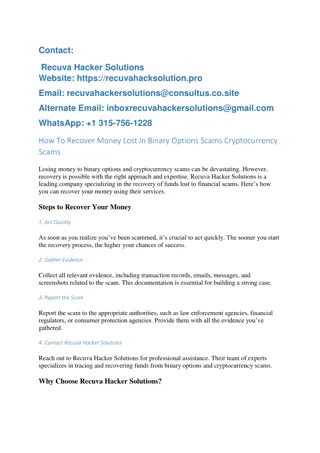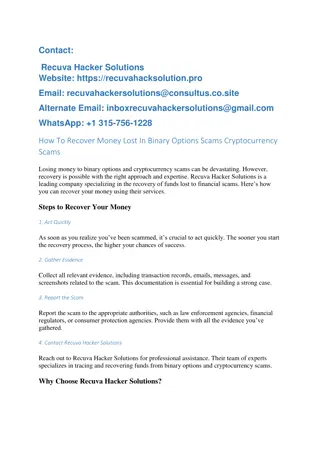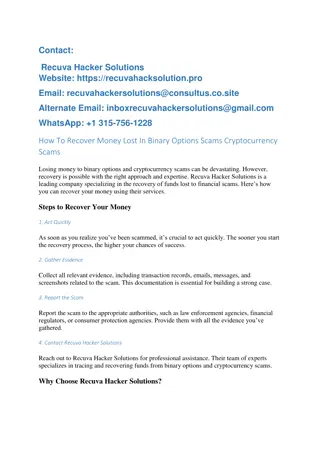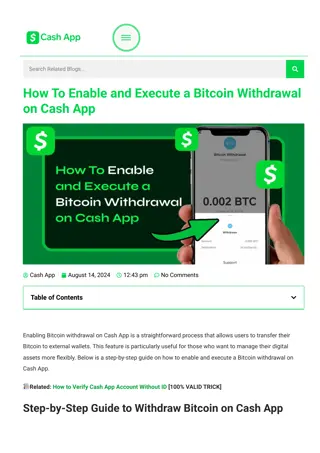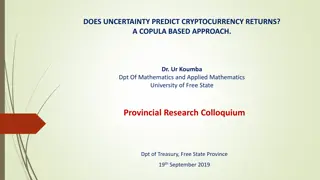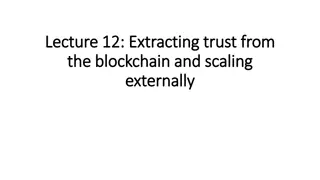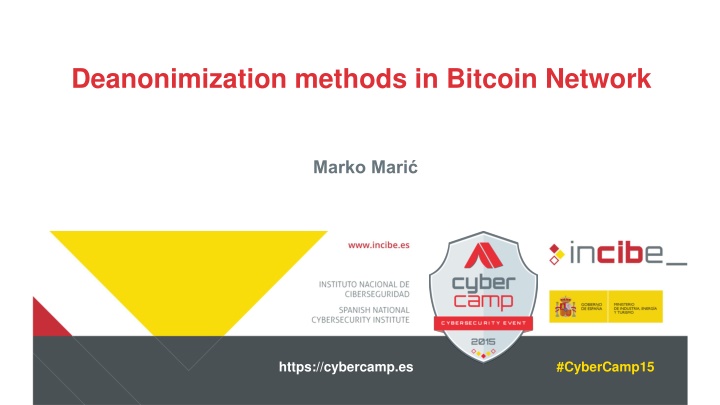
Deanonimization Methods in Bitcoin Network Analysis
Explore the process of deanonymizing transactions in the Bitcoin network through real-time network analysis, transaction graph analysis, and clustering experiments, uncovering methods used for identifying users and linking inputs to individuals.
Download Presentation

Please find below an Image/Link to download the presentation.
The content on the website is provided AS IS for your information and personal use only. It may not be sold, licensed, or shared on other websites without obtaining consent from the author. If you encounter any issues during the download, it is possible that the publisher has removed the file from their server.
You are allowed to download the files provided on this website for personal or commercial use, subject to the condition that they are used lawfully. All files are the property of their respective owners.
The content on the website is provided AS IS for your information and personal use only. It may not be sold, licensed, or shared on other websites without obtaining consent from the author.
E N D
Presentation Transcript
Deanonimization methods in Bitcoin Network Marko Mari https://cybercamp.es #CyberCamp15
Index Brief introduction Transaction graph analysis Real-time network analysis 2
Introduction Peer-to-peer network Peers are generating transactions and broadcast them on network Miners are peers that are collecting transactions and trying to generate block Block = collected transactions + proof-of-work Miner that first inserts proof-of-work in block is broadcasting block to network All peers are adding new blocks on top of previous ones - building it's own blockchain Bitcoin network Block N Block N-1 Block 3 Block 2 Block 1 3 Blockchain
Transaction graph analysis Blockchain transaction graph Identity is hidden, but all transactions are public Main concepts Input = Output Change address Transaction fee 4
How to deanonimize using blockchain? Wallets Containers for private/public keys (not coins!) Implemented as structured files or simple database Managed by wallet software Proof of shared control Asembling input of transaction from multiple addresses 5
How to deanonimize using blockchain? Tagged users Web crawling blockchain.info bitcointalk.org Active collecting Mining pools Online wallets Exchanges Merchants Gambling 6
Clustering Linking different inputs to same user Transaction inputs with shared address can be link together 2 transactions with inputs (A, B) and (B, C) belongs to user that owns keys A, B, C Quick expansion of cluster Tagging clusters One tagged address in cluster tags all cluster Combining clusters Clusters with same tag combined in one cluster 7
Clustering experiment results Meiklejohn et al., December 2013 Blockchain parsed and analyzed 16.086.073 transactions, 12.056.684 public keys 5.579.176 clusters of users 5.577.481 combined clusters (20 clusters tagged to Mt.Gox) Excluded sink addresses 8
Privacy recommendation Use new addresses to receive payments Use multiple wallets for different purposes Bitcoin address should only be used once generating new change address Change returned to sending address -> Change returned to new address -> 9
Adding change address to inputs Change address is hard to recognize Depends on wallet software change-handling methods Single Address Wallets Random Address Pool Wallets Deterministic Address Pool Wallets User settings Heuristics Users rarely issue transactions to two different users -> obsolete Change address amount is not greater then lowest input amount -> obfuscated? Change address is used in only one output over all past transactions -> is it safe? 10
Change address heuristic Add to input list; address that is used only once in output over all past transactions Discard coin generation transactions Discard transactions with self-change address Discard transactions that have more then one output met CA condition Experiment results (Meiklejohn et al., December 2013) 4 million change addresses 555.348 false positives (13 percent) 11
Refining heuristic 12 percent are payback addresses Reducing to 1 percent of false postivies Waiting to label as change 1 day false postivies to 0.28% 1 week false postivies to 0.17% End up with mega cluster containing Mt. Gox, Instawallet, BitPay, Silk Road! Further refining (breaking mega cluster) 3.5 million change addresses 3.384.179 clusters 2.197 tagged clusters (1.8 million addresses) Started with 1.070 tagged addresses 12
How this can help me? Direct payments to/from servis From observed Bitcoin address To observed Bitcoin address Indirect payments to/from servis From observed Bitcoin address over anonymous transactions To observed Bitcoin address over anonymous transactions 13
Real time network analysis Linking Bitcoin addresses to IP addresses Possible to distinguish different users behind NAT Linking of different transactions to same user Even if they look completely unrelated in transaction graph analysis Problem using proxies VPNs, SOCKS proxy, TOR SOLUTION: Shutdown of Bitcoin over TOR! 14
Clients and servers SERVERS CLIENTS Each peer is trying to connect to 8 entry nodes Network discovery Servers Receive incoming connections Max. 117 incoming connections Clients 8 outgoing connections Peers are distinguished over set of it s entry nodes! 8.000 100.000 15
Disconnecting TOR Exploiting Bitcoin DOS protection IP addresses delivering malformed messages are banned for 24 hours Bann exit node 1 Bann exit node 2 Bann exit node 1 Bann exit node 2 1000 TOR exit nodes X 8000 Bitcoin servers ----------------- 1GB of traffic Bann exit node 1 Bann exit node 2 Exit node 1 Exit node 2 16
Address propagation Keeps network alive Nodes come and go ADDR message Peer advertises his address in network After connecting to another node Every 24 hours Address propagation Received address is stored to local database Propagated to two responsible nodes Address is not sent over this connections again ! 17
Choosing responsible nodes For each address X decide individually where to forward: Calculate hash = H(addr X, salt, current day, &peer struct) Sort 0x4b227777d4dd1fc61c 0x4e07408562bedb8b6f 0x5feceb66ffc86f38d953 0xd4735e3a265e16eee0 0xe7f6c011776e8db7cd2 0xef2d127de37b942baa5 These two peers are responsible nodes for address X 18
Learning entry nodes ATTACKER SERVERS CLIENTS 1 Entry nodes [2, 3, 4] 2 C Caentry nodes [2 ,3,4] 3 4 5 19
Problem ATTACKER SERVERS CLIENTS 1 Entry nodes [2, 3, 4] 2 C Caentry nodes [1 ,3,4] 3 4 5 20
Solution Based on fact that same address is never resent over same connection History is cleared after 24 hours Strategy Periodically on all attacker peers: 1. Broadcast ADDR to deanonymize 2. Establish number of connections 21
Learning part of entry nodes ATTACKER SERVERS CLIENTS 1 Entry nodes [2, 3, 4] 2 C Caentry nodes [3,4] 3 4 5 23
Metrics Peer can be uniquely identified with 3 entry nodes 105 105 8 103 3 1 - Collison is unlikely 35 connections to each server should be enough ??????,? = 1 ? On average 4 ADDR messages will be forwarded to attacker How often to broadcast address? ????????,? ????????? ,??????????,???? 2014 Experiment: 10 minutes seems to be reasonable choice ? ? 1 ? 1; ?????90,125 = 0.49 24
What do we have? What we have? ADDR(Ca) = (3,5,11,13,17) ADDR(Cb) = (5,7,13,9,2) ADDR(Cc) = (1,7,4,5) How to deanonymize transaction? Client and attacker are connected with one hop over entry node All other connections between them are 2 hops or more Attacker will see transaction coming from entry nodes before then from any others. 25
Transaction propagation Client > entry node -> attacker (2 x INVENTORY, 2 x GETDATA, 1 x TRANSACTION) 5 messages, 16 checks, random trickling delay Client > entry node -> peer A -> attacker (3 x INVENTORY, 3 x GETDATA, 2 x TRANSACTION) 8 messages, 32 checks, 2 random trickeling delays 26
How to deanonimize transaction? First 15 transactions Receiving transaction from different peers Peers(Trans1): [ ,19 ] Checking transaction against different EN sets ADDR(Ca) Peers(Trans1) = ADDR(Cb) Peers(Trans1) = ADDR(Cc) Peers(Trans1) = Entry nodes (EN) sets: ADDR(Ca) = (3,5,11,13,17) ADDR(Cb) = (5,7,13,9,2) ADDR(Cc) = (1,7,4,5) 3,5,10,8,1,2,12,17,6,14,11,9,7,4,13 (3,5,17,11,13) (5,2,9,7,13) (5,1,7,4) It is ambiguous if Caor Cbor Ccgenerated transaction 27
How to deanonimize transaction? First 6 transactions Receiving transaction from different peers Peers(Trans1): [ ,12,17,6,14,11,9,7,4,13 ,19 ] Checking transaction against different EN sets ADDR(Ca) Peers(Trans1) = ADDR(Cb) Peers(Trans1) = ADDR(Cc) Peers(Trans1) = Entry nodes (EN) sets: ADDR(Ca) = (3,5,11,13,17) ADDR(Cb) = (5,7,13,9,2) ADDR(Cc) = (1,7,4,5) 3,5,10,8,1,2 (3,5) (5,2) (5,1) Not enough to distinguish client (3 nodes needed)! ? ?? ?? ?? ?? ?? ?? ?? ?, ? ? ? ?? ?? ?? ?? ?? ?? ?? ?? ? , ? ?? ?? ?? ?? ?? ?? ?? ?? ?? ?, ? ?? ?? ?? ? 2014: best balance is q=10 28
How to deanonimize transaction? First 10 transactions Receiving transaction from different peers Peers(Trans1): [ , ,11,9,7,4,13 ,19 ] Checking transaction against different EN sets ADDR(Ca) Peers(Trans1) = ADDR(Cb) Peers(Trans1) = ADDR(Cc) Peers(Trans1) = Entry nodes (EN) sets: ADDR(Ca) = (3,5,11,13,17) ADDR(Cb) = (5,7,13,9,2) ADDR(Cc) = (1,7,4,5) 3,5,10,8,1,2,12,17,6,14 (3,5, 17) (5,2) (5,1) Node Ca generated transaction 29
Experiment results (????????, ? ????????? , ??????????, ???? 2014) Bitcoin testnet 250 bitcoin servers Custom attacker client Bitcoin Core (Clients) Metrics Propagation of ADDR messages each 10 minutes Count for only first 10 nodes to forward transaction 3 entry nodes for identification Result 59.9% of transactions was successfully deanonymized 30
Conclusions On real Bitcoin network - estimations If attacker maintains 50 connections to servers ??? ????? = 0.34 Successful deanonymization ????????(3) = 0.11 31
How this can help me? Direct deanonymization Indirect deanonymization Deanonymization of Bitcoin address that made/receive payment to/from target Combining with transaction graph analysis Linkage of Bitcoin addresses that are unrealted in transaction graph 32
Final words.. Network RT analysis requires IP address beforehand Estimated success rate is very poor Ethics 33
https://cybercamp.es #CyberCamp15 @CyberCampEs

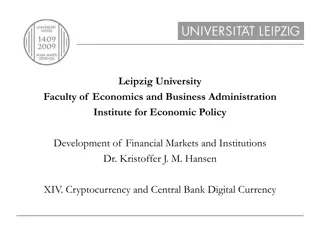

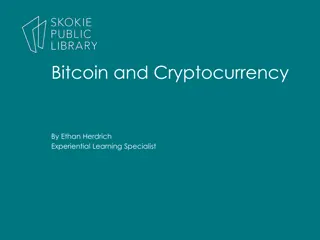
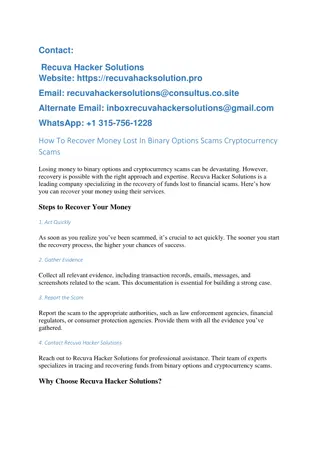

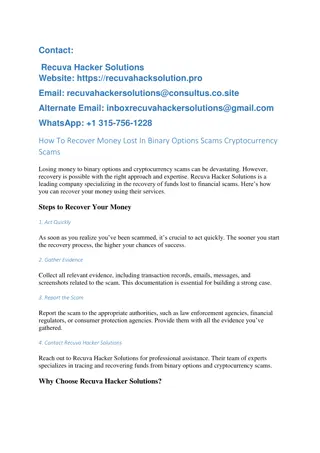

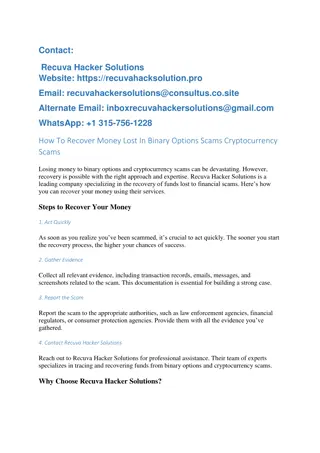
![101 Reviews How to Recover Lost Bitcoin [Scammed/Stolen Funds]](/thumb/153354/101-reviews-how-to-recover-lost-bitcoin-scammed-stolen-funds.jpg)
